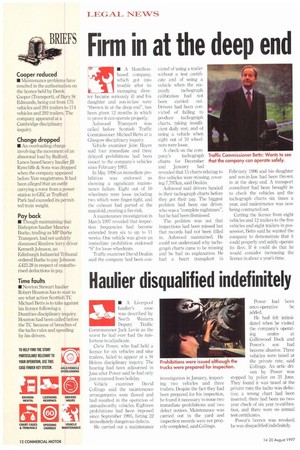'" Firm in at the deep end
Page 14

If you've noticed an error in this article please click here to report it so we can fix it.
• A Hamiltonbased company, which got into trouble after its managing director became seriously ill and his daughter and son-in-law were "thrown in at the deep end", has been given 12 months in which to prove it can operate properly.
Ashwood Transport was
called before Scottish TrafficCommi&sioner Michael Betts at a
Glasgow disciplinary inquiry.
Vehicle examiner John Hayes said four immediate and three delayed prohibitions had been issued to the company's vehicles since February 1993.
In May 1996 an immediate prohibition was endorsed as showing a significant maintenance failure. Eight out of 10 wheelnuts were loose including two which were finger-tight, and the exhaust had parted at the manifold, creating a fire risk.
A maintenance investigation in March 1997 revealed that inspection frequencies had become extended from six to up to 11 weeks. One vehicle was given an immediate prohibition endorsed "S" for loose wheelnuts.
Traffic examiner David Deakin said the company had been con victed of using a trailer without a test certificate and of using a vehicle when the six yearly tachograph calibration had not been carried out. Drivers had been convicted of failing to produce tachograph charts, taking insufficient daily rest, and of using a vehicle when eight out of 10 wheelnuts were loose.
A check on the com pany's tachograph charts for December and January had revealed that 15 charts relating to five vehicles were missing, covering 7,797km, said Deakin.
Ashwocx.1 said drivers handed in their tachograph charts before they got their pay. The biggest problem had been one driver, who was a "complete nightmare", but he had been dismissed.
The problem was not that inspections had been missed but that records had not been filled in, Ashwood maintained. He could not understand why tachograph charts came to be missing and he had no explanation. He had a heart transplant in February 1996 and his daughter and son-in-law had been thrown in at the deep end. A transport consultant had been brought in to check the vehicles and the tachograph charts six times a year, and maintenance was now being contracted out.
Cutting the licence from eight vehicles and 12 trailers to the five vehicles and eight trailers in possession, Betts said he wanted the company to demonstrate that it could properly and safely operate its fleet. If it could do that he would consider increasing the licence in about a year's time.
















































































































